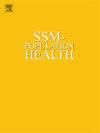大流行后社会经济上处于不利地位的年轻人焦虑和抑郁症状网络的变化:一项重复的横断面研究
IF 3.1
2区 医学
Q1 PUBLIC, ENVIRONMENTAL & OCCUPATIONAL HEALTH
引用次数: 0
摘要
2019冠状病毒病大流行严重影响了年轻人的心理健康,特别是那些面临社会经济困难的年轻人。虽然大流行后一般人群的心理困扰似乎有所减少,但弱势亚群体的风险仍然较高。网络分析提供了一种跨诊断的方法来理解抑郁和焦虑症状随时间的动态相互作用。方法我们在2020年(T1)和2024-2025年(T2)对社会经济条件较差的年轻人进行了重复横断面研究。使用PHQ-9和GAD-7评估抑郁和焦虑症状。使用EBICglasso的高斯图形模型估计症状网络。网络比较测试(NCT)评估网络结构和症状中心性的变化。进行聚类分析以探索症状分组随时间的重组。结果在T1 (n = 960)和T2 (n = 380)之间,抑郁(PHQ-9: 9.43 ~ 11.35, p < 0.001)和焦虑(GAD-7: 6.3 ~ 8.14, p < 0.001)的平均得分均显著升高。自杀意念几乎翻倍(25.9% - 42.9%,p < 0.001)。网络分析显示T2时抑郁和焦虑症状之间有更强的相互联系。焦虑症状(尤其是GAD3、GAD2和GAD1)变得更为中心,而自杀意念从抑郁症特异性集群转移到一个整合焦虑症状的集群。聚类分析支持抑郁和焦虑领域的渐进式整合。结论:我们的研究结果表明,大流行后的精神病理网络不断发展,焦虑症状变得越来越重要,与自杀意念密切相关。这些结果强调了针对抑郁和焦虑进行有针对性干预的必要性,特别是在社会经济脆弱的年轻人中,以更有效地降低这一人群的自杀风险。本文章由计算机程序翻译,如有差异,请以英文原文为准。
Post-pandemic changes in anxiety and depression symptom networks among socioeconomically disadvantaged young Adults: A repeated cross-sectional study
Background
The COVID-19 pandemic has significantly affected the mental health of young adults, particularly those facing socioeconomic hardship. Although psychological distress appears to be declining in the general population post-pandemic, vulnerable subgroups remain at elevated risk. Network analysis offers a transdiagnostic approach to understanding the dynamic interplay of depressive and anxiety symptoms over time.
Methods
We conducted a repeated cross-sectional study among socioeconomically disadvantaged young adults in 2020 (T1) and 2024–2025 (T2). Depressive and anxiety symptoms were assessed using the PHQ-9 and GAD-7. Symptom networks were estimated using Gaussian Graphical Models with EBICglasso. The Network Comparison Test (NCT) evaluated changes in network structure and symptom centrality. Clustering analysis was performed to explore the reorganization of symptom groupings over time.
Results
Mean scores increased significantly between T1 (n = 960) and T2 (n = 380) for both depression (PHQ-9: 9.43 to 11.35, p < 0.001) and anxiety (GAD-7: 6.3 to 8.14, p < 0.001). Suicidal ideation nearly doubled (25.9 %–42.9 %, p < 0.001). Network analysis revealed stronger interconnections between depressive and anxiety symptoms at T2. Anxiety symptoms (particularly GAD3, GAD2, and GAD1) became more central, while suicidal ideation shifted from a depression-specific cluster to one integrating anxiety symptoms. Clustering analysis supported a progressive integration of depressive and anxiety domains.
Conclusion
Our findings suggest an evolving post-pandemic psychopathological network, with anxiety symptoms becoming increasingly central and closely linked to suicidal ideation. These results underscore the need for targeted interventions addressing both depression and anxiety, particularly among socioeconomically vulnerable young adults, to more effectively reduce suicide risk in this population.
求助全文
通过发布文献求助,成功后即可免费获取论文全文。
去求助
来源期刊

Ssm-Population Health
PUBLIC, ENVIRONMENTAL & OCCUPATIONAL HEALTH-
CiteScore
6.50
自引率
2.10%
发文量
298
审稿时长
101 days
期刊介绍:
SSM - Population Health. The new online only, open access, peer reviewed journal in all areas relating Social Science research to population health. SSM - Population Health shares the same Editors-in Chief and general approach to manuscripts as its sister journal, Social Science & Medicine. The journal takes a broad approach to the field especially welcoming interdisciplinary papers from across the Social Sciences and allied areas. SSM - Population Health offers an alternative outlet for work which might not be considered, or is classed as ''out of scope'' elsewhere, and prioritizes fast peer review and publication to the benefit of authors and readers. The journal welcomes all types of paper from traditional primary research articles, replication studies, short communications, methodological studies, instrument validation, opinion pieces, literature reviews, etc. SSM - Population Health also offers the opportunity to publish special issues or sections to reflect current interest and research in topical or developing areas. The journal fully supports authors wanting to present their research in an innovative fashion though the use of multimedia formats.
 求助内容:
求助内容: 应助结果提醒方式:
应助结果提醒方式:


